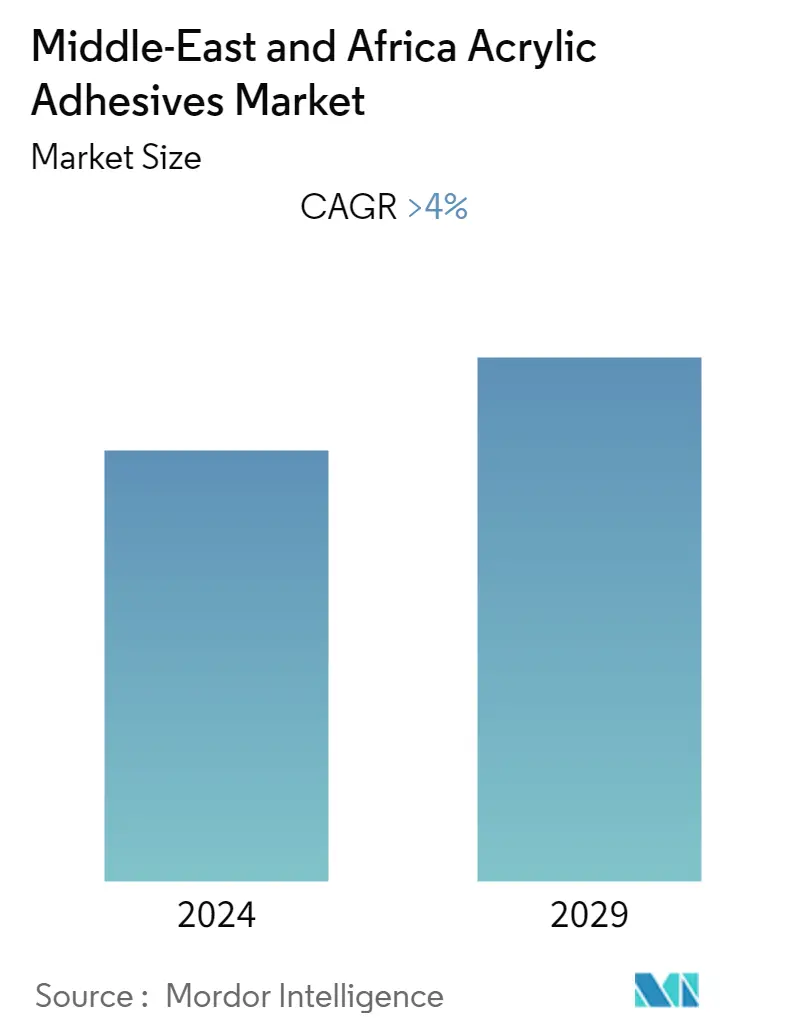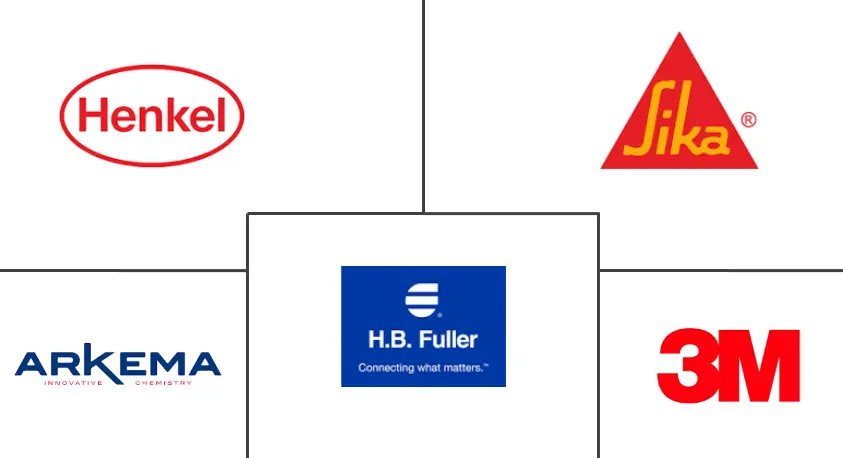Market Size of Middle-East and Africa Acrylic Adhesives Industry

| Study Period | 2019 - 2029 |
| Base Year For Estimation | 2023 |
| Forecast Data Period | 2024 - 2029 |
| Historical Data Period | 2019 - 2022 |
| CAGR | 4.00 % |
| Market Concentration | Low |
Major Players
*Disclaimer: Major Players sorted in no particular order |
MEA Acrylic Adhesives Market Analysis
Middle-East and Africa acrylic adhesives market is expected to grow at a CAGR of over 4% during the forecast period. The demand for acrylic adhesives is widely driven by the robust growth of construction activities and high dependency on processed and packaged food products. However, stringent VOC emission regulations related to acrylic adhesives disposal and/or substitution from different feedstock may hinder the growth of the studied market.
- The water-based acrylic adhesives segment is expected to be the fastest growing segment, owing to the increasing consumer awareness about the ill-effects of solvent-based adhesives on environment and human health.
- Replacement of solvent-borne adhesives in construction industry and shifting focus towards the bio-based adhesives are likely to offer opportunities for the acrylic adhesives market in the region.
- Saudi Arabia stands to be the largest market for acrylic adhesives in the region, with consumption being majorly driven by the growth in construction, woodworking and packaging industries.
MEA Acrylic Adhesives Industry Segmentation
Middle-East and Africa acrylic adhesives market report include:
| Technology | |
| Water-based | |
| Solvent-based | |
| Reactive | |
| Other Technologies |
| End-user Industry | |
| Building and Construction | |
| Electrical and Electronics | |
| Packaging | |
| Sporting Goods | |
| Transportation | |
| Woodworking | |
| Other End-user Industries |
| Geography | |
| Saudi Arabia | |
| South Africa | |
| United Arab Emirates | |
| Qatar | |
| Rest of Middle-East and Africa |
Middle-East and Africa Acrylic Adhesives Market Size Summary
The Middle-East and Africa acrylic adhesives market is poised for significant growth, driven by the expansion of construction activities and the increasing reliance on processed and packaged food products. The market is experiencing a shift towards water-based acrylic adhesives, propelled by heightened consumer awareness regarding the environmental and health impacts of solvent-based alternatives. This transition is further supported by the construction industry's move away from solvent-borne adhesives and a growing emphasis on bio-based solutions. Saudi Arabia emerges as the dominant market within the region, fueled by its burgeoning construction, woodworking, and packaging sectors. The packaging industry, in particular, plays a crucial role in the consumption of acrylic adhesives, as these adhesives are essential in producing a variety of products, including tapes, cases, labels, and cartons.
The demand for acrylic adhesives in the Middle-East and Africa is also bolstered by the rising consumption of fast-moving consumer goods, especially in countries like Saudi Arabia, Qatar, and the United Arab Emirates. The surge in e-commerce and online food deliveries has amplified the need for packaging materials, thereby increasing the demand for adhesives used in packaging. Saudi Arabia's ambitious construction projects, such as the Neom mega-city and The Red Sea Project, are expected to further drive the demand for acrylic adhesives in the construction industry. Additionally, the country's packaging sector is witnessing a transition from rigid to flexible packaging, which enhances the application scope for acrylic adhesives. This trend, coupled with the growing need for flexible, safe, and sustainable packaging, is anticipated to create lucrative opportunities for the acrylic adhesives market in the region over the forecast period. The market remains fragmented, with key players including 3M, Arkema Group, Sika AG, H.B. Fuller, and Henkel AG & Co. KGaA.
Middle-East and Africa Acrylic Adhesives Market Size - Table of Contents
-
1. MARKET DYNAMICS
-
1.1 Drivers
-
1.1.1 High Packaging Demand from Food & Beverage Industry
-
1.1.2 Robust Growth of Construction Industry
-
-
1.2 Restraints
-
1.2.1 Availability of Alternative Feedstocks for Adhesives
-
1.2.2 Stringent Environmental Regulations Regarding VOC Emissions
-
-
1.3 Industry Value-chain Analysis
-
1.4 Porter's Five Forces Analysis
-
1.4.1 Bargaining Power of Suppliers
-
1.4.2 Bargaining Power of Consumers
-
1.4.3 Threat of New Entrants
-
1.4.4 Threat of Substitute Products and Services
-
1.4.5 Degree of Competition
-
-
-
2. MARKET SEGMENTATION
-
2.1 Technology
-
2.1.1 Water-based
-
2.1.2 Solvent-based
-
2.1.3 Reactive
-
2.1.4 Other Technologies
-
-
2.2 End-user Industry
-
2.2.1 Building and Construction
-
2.2.2 Electrical and Electronics
-
2.2.3 Packaging
-
2.2.4 Sporting Goods
-
2.2.5 Transportation
-
2.2.6 Woodworking
-
2.2.7 Other End-user Industries
-
-
2.3 Geography
-
2.3.1 Saudi Arabia
-
2.3.2 South Africa
-
2.3.3 United Arab Emirates
-
2.3.4 Qatar
-
2.3.5 Rest of Middle-East and Africa
-
-
Middle-East and Africa Acrylic Adhesives Market Size FAQs
What is the current Middle-East and Africa Acrylic Adhesives Market size?
The Middle-East and Africa Acrylic Adhesives Market is projected to register a CAGR of greater than 4% during the forecast period (2024-2029)
Who are the key players in Middle-East and Africa Acrylic Adhesives Market?
3M, Arkema Group, Henkel AG & Co. KGaA, Sika AG and H.B. Fuller are the major companies operating in the Middle-East and Africa Acrylic Adhesives Market.

